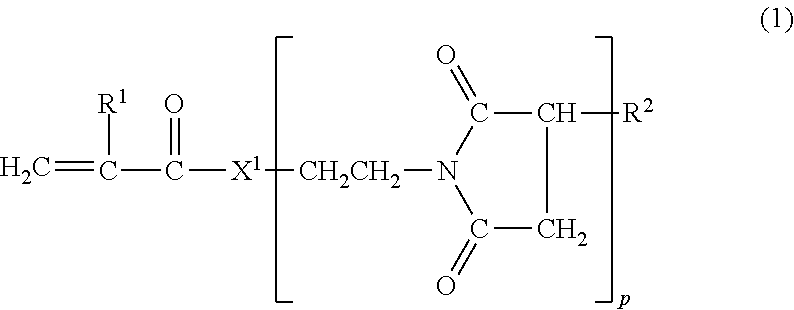Viscosity index improver and lubricating oil composition
- Summary
- Abstract
- Description
- Claims
- Application Information
AI Technical Summary
Benefits of technology
Problems solved by technology
Method used
Image
Examples
production example 1
[0159]A reaction vessel equipped with a temperature adjuster, a vacuum stirrer blade, a nitrogen inlet, and a nitrogen outlet was charged with polybutene having an unsaturated group at an end [product name “Polybutene 10N”; NOF Corporation; Mn: 1,000] (280 parts by weight), a 1 mol / L solution of tetrahydrofuran-boron•tetrahydrofuran [Wako Pure Chemical Industries, Ltd.] (400 parts by weight), and tetrahydrofuran (400 parts by weight), and hydroboration was carried out at 25° C. for 4 hours. Subsequently, water (50 parts by weight), a 3N—NaOH aqueous solution (50 parts by volume), and a 30% by weight hydrogen peroxide (50 parts by volume) were added for oxidation. The supernatant was collected in a separating funnel, and the temperature was raised to 50° C. Then, tetrahydrofuran was removed over 2 hours under reduced pressure (in the range of 0.027 to 0.040 MPa) at the same temperature. Thus, a hydroxyl group-containing polymer (Y2-1) was obtained. The total number of isobutylene and...
production example 2
[0160]A SUS pressure-resistant reaction vessel equipped with a temperature adjuster and a stirrer was charged with polybutene having an unsaturated group at an end [product name “Polybutene 200N”; NOF Corporation; Mn: 2,650] (530 parts by weight) and maleic anhydride [Wako Pure Chemical Industries, Ltd.] (25 parts by weight), and the temperature was raised to 220° C. while stirring. Then, an ene reaction was carried out for 4 hours at the same temperature. Subsequently, the temperature was cooled to 25° C., and 2-aminoethanol (20 parts by weight) was added. The temperature was raised to 130° C. while stirring. Then, an imidization reaction was carried out for 4 hours at the same temperature. An unreacted maleic anhydride and 2-amino alcohol were removed over 2 hours under reduced pressure (in the range of 0.027 to 0.040 MPa) at a temperature of 120° C. to 130° C. Thus, a hydroxyl group-containing polymer (Y3-1) was obtained. The total number of isobutylene and 1,2-butylene based on ...
examples 1 to 8
, Comparative Examples 1 to 6
[0161]A reaction vessel equipped with a stirrer, a heating and cooling device, a thermometer, and a nitrogen inlet tube was charged with a base oil A (SP: 8.3 (cal / cm3)1 / 2; kinematic viscosity at 100° C.: 4.2 mm2 / s; viscosity index: 128) (400 parts by weight), a monomer mixture described in Table 2 (100 parts by weight), 2,2′-azobis(2,4-dimethyl valeronitrile) (0.5 parts by weight), and 2,2′-azobis(2-methylbutyronitrile) (0.2 parts by weight), and the reaction vessel was purged with nitrogen (gas-phase oxygen concentration: 100 ppm). Subsequently, the temperature was raised to 76° C. while stirring under hermetically sealed conditions, and a polymerization reaction was carried out for 4 hours at the same temperature. After the temperature was raised to 120° C. to 130° C., an unreacted monomer was removed over 2 hours under reduced pressure (in the range of 0.027 to 0.040 MPa) at the same temperature. Thus, viscosity index improvers (R1) to (R8) and (S1) ...
PUM
| Property | Measurement | Unit |
|---|---|---|
| Temperature | aaaaa | aaaaa |
| Percent by mass | aaaaa | aaaaa |
| Pressure | aaaaa | aaaaa |
Abstract
Description
Claims
Application Information
 Login to View More
Login to View More - R&D
- Intellectual Property
- Life Sciences
- Materials
- Tech Scout
- Unparalleled Data Quality
- Higher Quality Content
- 60% Fewer Hallucinations
Browse by: Latest US Patents, China's latest patents, Technical Efficacy Thesaurus, Application Domain, Technology Topic, Popular Technical Reports.
© 2025 PatSnap. All rights reserved.Legal|Privacy policy|Modern Slavery Act Transparency Statement|Sitemap|About US| Contact US: help@patsnap.com



